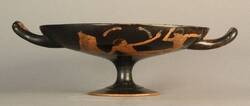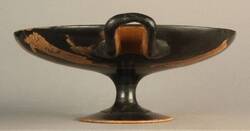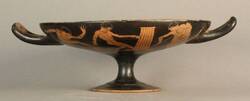The shallow bowls are decorated with scenes from the palaestra – the wrestling school. We can see naked athletes, their bodies rubbed with oil. Apart from a complex of facilities such as practice and changing rooms, the palaestra had a square sports ground around 90 metres long on each side – slightly shorter than a football pitch. Together with the dromos, the racetrack, the palaestra formed the gymnasium – a place not only training athletes and soldiers, but also providing a humanist education.
In all the ancient Greek city states, sport was surprisingly important in society. Along with the Olympic Games, the most famous games, there were any number of larger and smaller sporting events, always linked to festivals and sacrificial cults. On the edges of the event, politics and business were discussed and deals done. Literary works were presented or performed, artists exhibited their works, and state agreements were publicly announced, literally carved in stone.
On the final day, the winners attended a lavish banquet. Such celebrations, of course, also involved drinking – with, for instance, wine out of shallow bowls like these.
If you now look at the bowl missing larger orange-coloured areas, you’ll see the outer decorations show two groups of two athletes. Those on the left are each holding an object which looks rather like a boomerang. These are strigils – a kind of scraper used after sports to remove the crust of oil, sand and sweat from the skin before the athletes bathed.
Further Media
- Location & Dating
- Attic, 490/480 BCE
- Material & Technique
- Clay
- Dimenions
- H: 9,2 cm (r.) 9,4 cm (l.), Dm: 23,7 cm, B über He: 31,1 cm, DmF: 10,1 cm, Wst Lippe: 0,3 cm, Dm He: 1 cm, Dm Ok Standlinie: 10,4 cm, Dm Todo: 14,8 cm, Dm Brennstütze: ca. 13 cm
- Museum
- Skulpturensammlung
- Inventory number
- Dr. 304


